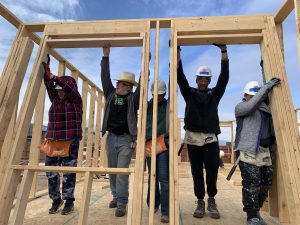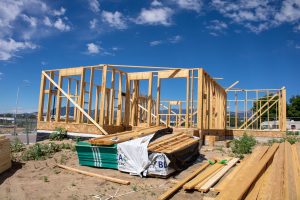 Pikes Peak Habitat for Humanity is always trying to build more energy-efficient, sustainable homes — both because this keeps costs down for our homeowners and because we feel called to be responsible with our finite resources.
Pikes Peak Habitat for Humanity is always trying to build more energy-efficient, sustainable homes — both because this keeps costs down for our homeowners and because we feel called to be responsible with our finite resources.
When we frame our homes, one step we take that might seem counter-intuitive is using wood, rather than steel framing members.
“The steel is shaped like the letter C, and it provides a lot of rigidity for that downward pressure from gravity,” explains Eric Wells, Pikes Peak Habitat director of construction services. “So one might think, Well, steel, it’s a material that’s infinitely recyclable, so it sounds like it would be the superior material.”
In an ideal world, that would be true, he says. “However, to create that steel, it takes a lot of energy. You have to pour a lot of energy into making it, and if all that energy came from renewable sources, that wouldn’t be bad, but these days, that’s just not the case.”
Wood is both renewable and a better choice environmentally.

“Wood is a carbon sink,” explains Wells. “Wood is almost entirely made up of carbon, and so that carbon is not being released into the atmosphere in the form of a greenhouse gas. It’s being stored in the house.”
But isn’t cutting down trees the opposite of a sustainable practice?
Not really, explains Wells.
“Naturally, one might think, Well, you’re using trees; you’re cutting down forests; you’re stripping the land of its natural resources,” he says. “That was true for the majority of the industrial age, but a lot of companies have learned the value of having managed forests where trees are planted and then harvested 20, 40, 50, 80 years later to be reused in the house.”
 These forests don’t require irrigation, and as the trees grow, they absorb carbon dioxide from the air. Even after they are cut and used as lumber, they continue to store the carbon rather than releasing it back into the air.
These forests don’t require irrigation, and as the trees grow, they absorb carbon dioxide from the air. Even after they are cut and used as lumber, they continue to store the carbon rather than releasing it back into the air.
They also create jobs.
“These days, most of the lumber that’s being used is from managed forests, and this puts a lot of people to work,” Wells says. “These trees aren’t just going to grow by themselves.”
He concludes, “I’ve kind of come to grips that wood framing is pretty sustainable, and it does have a benefit that we currently need to utilize. In the future, if we’re running off 80, 90, 100 percent renewables, steel may be the way to go, and then that land [being used for managed forests] can get reclaimed by nature. But for now we’re just not there yet.”
In the meantime, Wells and the rest of the Pikes Peak Habitat construction crew continue to look for ways we can reduce the environmental impact of our work. We’ll keep seeking and finding innovative solutions to lower our carbon footprint and make our homes increasingly sustainable.

